Baby Carrier Buying Guide
6
Different Baby Carrying Positions
Baby carriers allow you to carry your baby in different positions, according to your
convenience, your baby’s comfort, age and other requirements. You can carry the baby
horizontally, as in a cradle, or vertically; in the front, or behind your back; facing you, or
facing out.
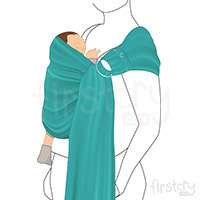
Here, you place your baby in a lying down position inside the baby carrier. The baby may be in a fully reclined or semi-reclined position. The baby carrier is usually worn first before slipping the baby into it. While this position is great for breastfeeding your newborn, it is not highly recommended by experts, since there is a risk of causing hip dysplasia4 or asphyxiation (suffocation) to the baby, if positioned improperly for a long time inside the carrier.
A reverse cradling position is similar to the cradling position, the only difference being that the baby’s head is placed on the side opposite to the shoulder supporting the carrier’s weight. This position too, like the cradle carry position, is good for breastfeeding. Both these cradling positions can be used for newborns to children under 3-4 months.
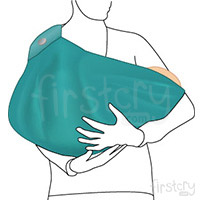
The front carry position is recommended for newborn babies and heavy babies. Front baby carrying position offers lumbar support, and provides the best weight distribution. Some manufacturers provide a unique two-piece design5 that allows caregivers to transfer sleeping babies from the carrier to crib, without disturbing their sleep. The adjustable straps at front allow all adjustments to be made from the front, easily. The front carrying position allows two directions –
The facing-in position can be used for newborns, until they are 4 months old. A newborn baby starts to adapt to life outside the womb by learning and trying to master the functions like breathing, vocalizing, digesting and seeing. The baby’s vision is limited to 8-10 inches, in the first few months. It is the same approximate distance between your face and your baby’s face, when holding your baby in your arms or when breastfeeding. This position provides head and neck support, and snuggling up to parents makes the baby feel more secure.
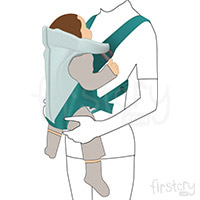
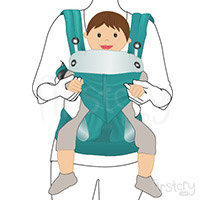
The facing-out position is suitable for older babies who have head and neck control. After 4 months, the front carry facing-out position would allow babies to explore their surroundings and interact with others. This position is also known as the Kangaroo carry position.
The hip carry position allows you to comfortably carry your baby in the natural carrying position. They are comfortable for both the wearer and the baby, are easy to use and made of quality design, materials and workmanship. The hip carriers are designed to distribute weight evenly, so you don’t slump to one side. They are also designed to provide support where you need it.
Hip carriers can be used for babies from 5 months onwards, till they weigh up to 16 kg. It allows the wearer and the baby to have face-to-face contact. In the hip carry position, the wide waist belt and the shoulder straps don’t impede arm movement, and the baby carrier buckles can easily be adjusted with one hand.
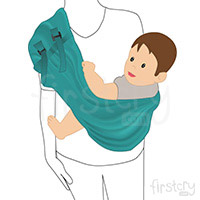
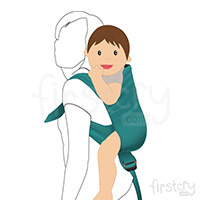
The back carry position is very convenient to baby wearers. It gives you more freedom to move around and do what you want. However, this is not recommended for your newborn or infant, who is yet to gain head-neck balance. The high back position is more suited for children who are old enough to sit independently behind your back, and able to look over your shoulders.

Cradle Carry
Here, you place your baby in a lying down position inside the baby carrier. The baby may be in a fully reclined or semi-reclined position. The baby carrier is usually worn first before slipping the baby into it. While this position is great for breastfeeding your newborn, it is not highly recommended by experts, since there is a risk of causing hip dysplasia4 or asphyxiation (suffocation) to the baby, if positioned improperly for a long time inside the carrier.
Reverse Cradle Carry
A reverse cradling position is similar to the cradling position, the only difference being that the baby’s head is placed on the side opposite to the shoulder supporting the carrier’s weight. This position too, like the cradle carry position, is good for breastfeeding. Both these cradling positions can be used for newborns to children under 3-4 months.

Front Carry
The front carry position is recommended for newborn babies and heavy babies. Front baby carrying position offers lumbar support, and provides the best weight distribution. Some manufacturers provide a unique two-piece design5 that allows caregivers to transfer sleeping babies from the carrier to crib, without disturbing their sleep. The adjustable straps at front allow all adjustments to be made from the front, easily. The front carrying position allows two directions –
Facing-in Position -
The facing-in position can be used for newborns, until they are 4 months old. A newborn baby starts to adapt to life outside the womb by learning and trying to master the functions like breathing, vocalizing, digesting and seeing. The baby’s vision is limited to 8-10 inches, in the first few months. It is the same approximate distance between your face and your baby’s face, when holding your baby in your arms or when breastfeeding. This position provides head and neck support, and snuggling up to parents makes the baby feel more secure.


Facing-out Position -
The facing-out position is suitable for older babies who have head and neck control. After 4 months, the front carry facing-out position would allow babies to explore their surroundings and interact with others. This position is also known as the Kangaroo carry position.
Hip Carry
The hip carry position allows you to comfortably carry your baby in the natural carrying position. They are comfortable for both the wearer and the baby, are easy to use and made of quality design, materials and workmanship. The hip carriers are designed to distribute weight evenly, so you don’t slump to one side. They are also designed to provide support where you need it.
Hip carriers can be used for babies from 5 months onwards, till they weigh up to 16 kg. It allows the wearer and the baby to have face-to-face contact. In the hip carry position, the wide waist belt and the shoulder straps don’t impede arm movement, and the baby carrier buckles can easily be adjusted with one hand.


Back Carry
The back carry position is very convenient to baby wearers. It gives you more freedom to move around and do what you want. However, this is not recommended for your newborn or infant, who is yet to gain head-neck balance. The high back position is more suited for children who are old enough to sit independently behind your back, and able to look over your shoulders.
